

Theunis Piersma, professor og migratory bird ecology
heralds of change in
the Wadden
Watchbirds

PHOTO: KEES VAN DE VEEN
READING TIME: 5 MINUTES
PROPOSITION
Berit Habbig Libutzki – Medical Sciences
‘Feminism isn’t about making women stronger. Women are already strong. It’s about changing the way the world perceives
that strength’ (G.D. Anderson)
Black-tailed godwit
The sixth bird on the list is the black-tailed godwit. As an inhabitant of our grasslands, it is not technically a wading bird, but since it is a much-loved breeding bird of the Wadden Islands and the North Holland, Frisian, and Groningen Wadden coast, it still belongs in the list. And, as an icon of Dutch farmland, it may rightly be called a ‘watchbird’. It was with good reason that the black-tailed godwit was voted our national bird in 2015. It is somewhat larger and slimmer than its bar-tailed counterpart, with a longer bill and longer legs, and it is slightly less brightly coloured. In autumn, black-tailed godwits fly to West Africa, only to return north during the winter.
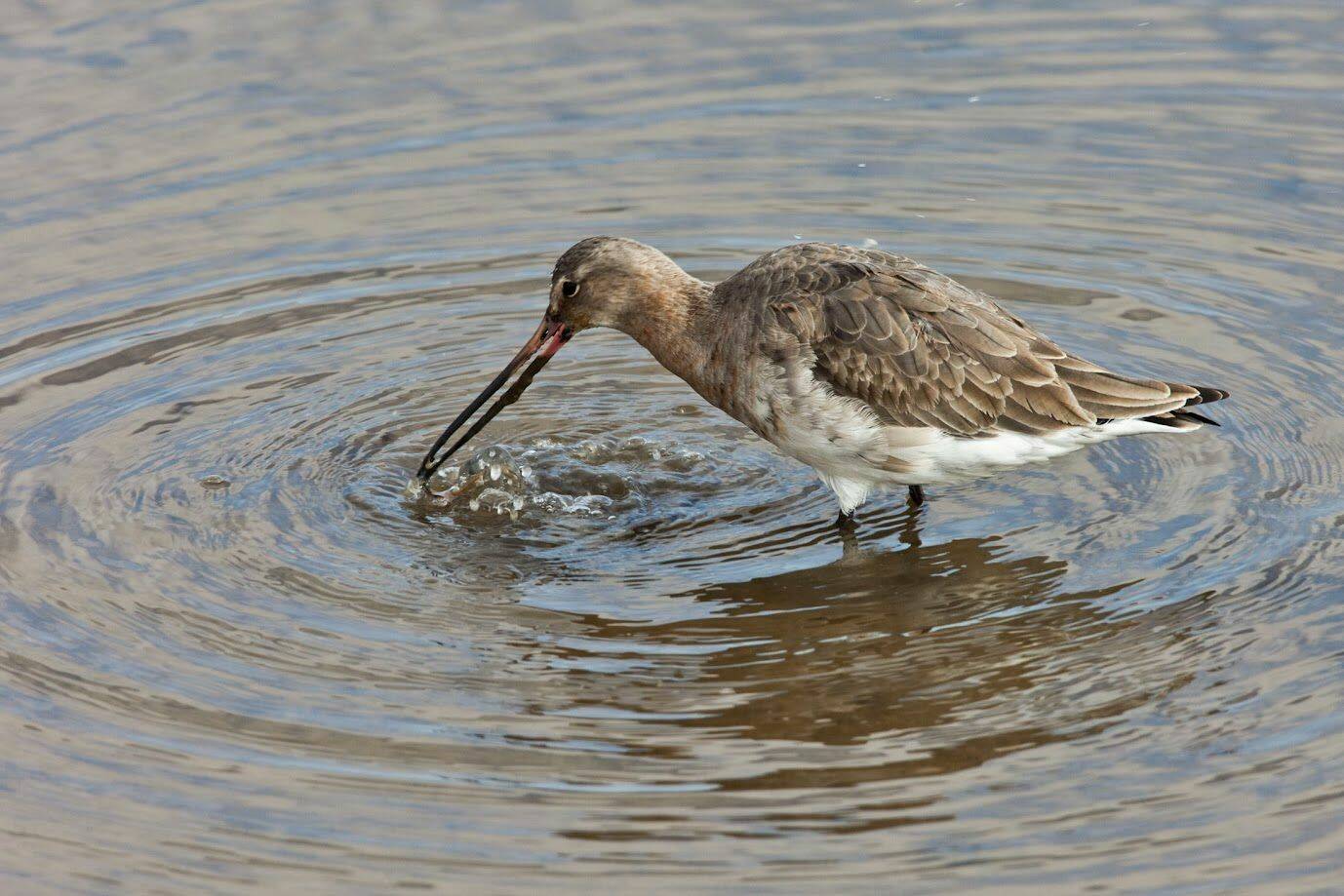
Bar-tailed godwit
This lesser-known cousin of our ‘common’ black-tailed godwit is somewhat smaller and stockier, and has a slightly upturned bill. It is a striking wading bird that prefers to eat bristle worms, such as lugworms and sandworms – but it also likes other invertebrates. Bar-tailed godwits breed in the far north and are mostly passing through here. Scandinavian breeders winter in the Wadden Sea; we also see birds on their way from Siberia to West Africa. The Pacific subspecies holds the world record for non-stop long-distance flying: in 2022,
a tagged Alaskan flew to Tasmania in 11 days, which is over 13,500 km in one go.

Sanderling
In small groups, they run ahead of the waves, back and forth on the beach, always moving. Their little legs move so fast they almost seem to float. Sanderlings are called three-toed-sandpiper in Dutch because they do not have a fourth toe like other birds: the hind toe is missing. They search for small creatures in the tide line on the beach. You can find them all along the coast, but especially in the Wadden area. Like knots, they breed in the high-Arctic tundra and, at that time, they are a deep rusty brown; here they are greyish-white, although they look black and white when in flight. Some stay with us all winter, while others migrate to West Africa.
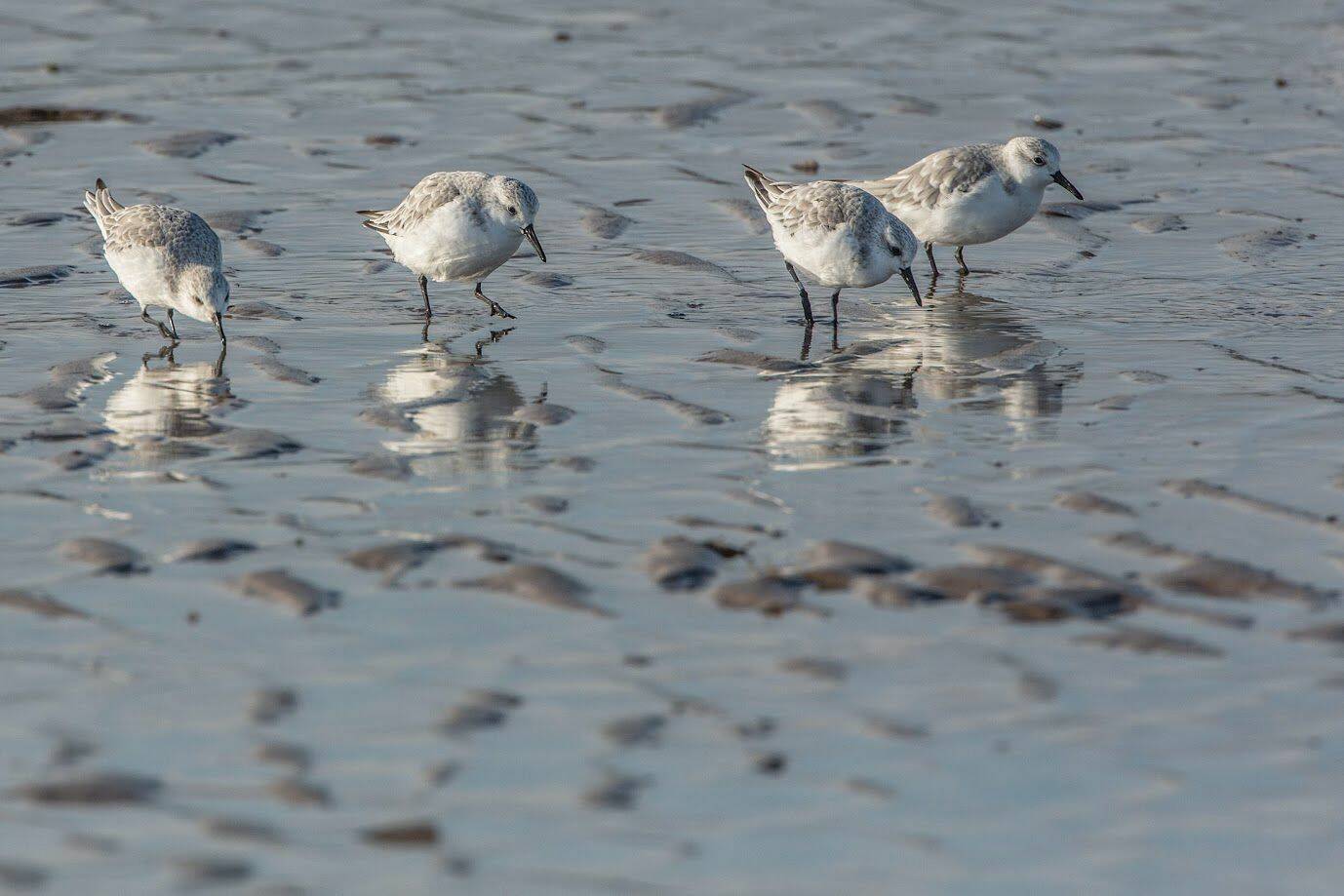
Knot
Our largest species of sandpiper is magnificent. It is grey and white in winter, but during summer it is colourful on top and reddish-brown underneath. Knots breed in the high Arctic and then flock to the Wadden to fatten up. The Siberians fly on to West Africa, but knots from Greenland and Canada, a separate subspecies, stay with us throughout the winter. This makes the Wadden Sea essential for this species. Knots are experts at finding shellfish on the tidal flats. You can often see them close together in large groups: resting on dry ledges or swarming through the air.
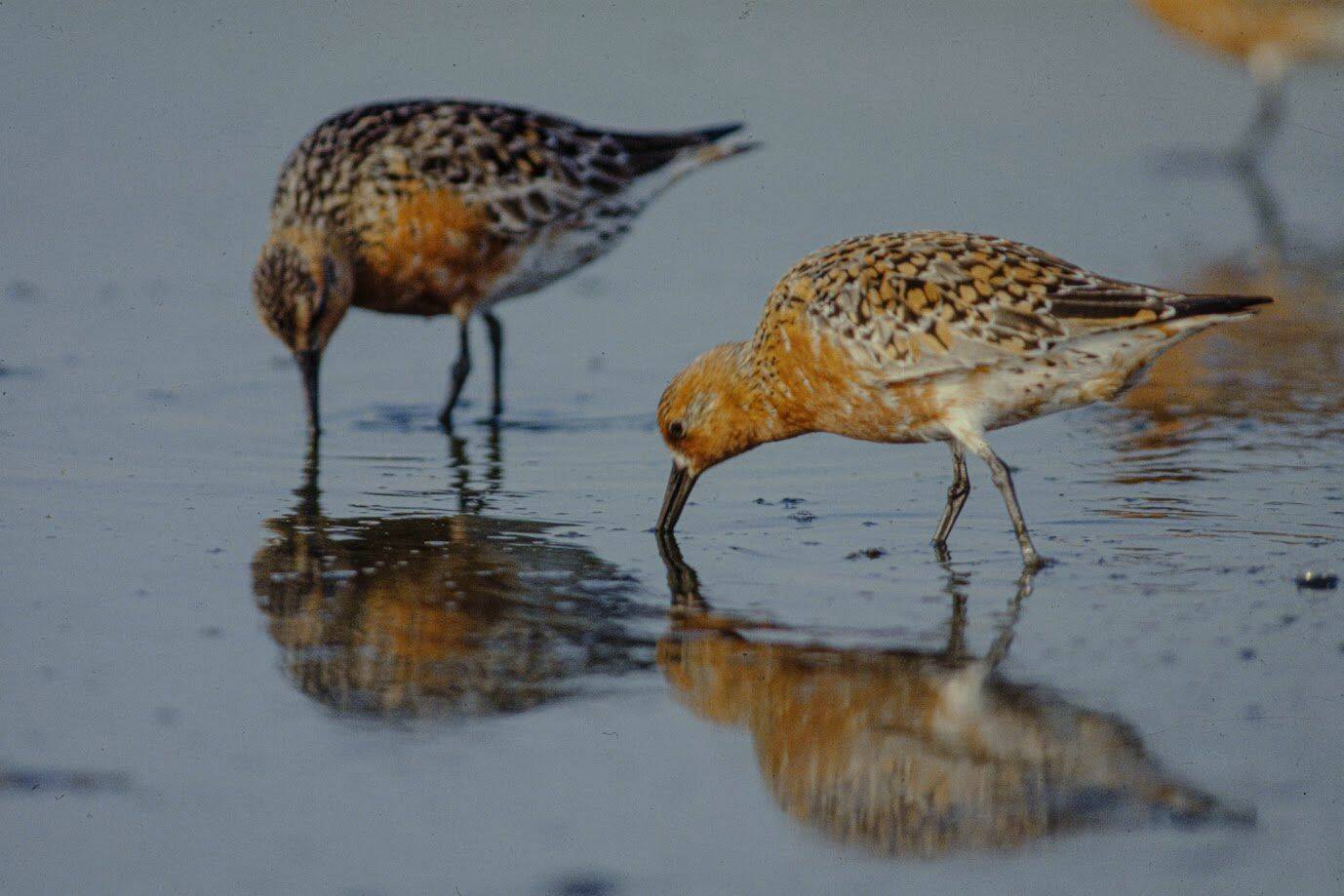
Spoonbill
Half a century ago, this was a rare bird in these parts. Now, almost four thousand pairs breed mainly in the Wadden area, but also in other coastal and marsh areas. The spoonbill is a migratory bird, like the brent goose, but this one breeds here and migrates for winter to southern Europe, or even further: to the mudflats along the coast of Mauritania. Spoonbills forage in shallow water: in gullies on the mud flats and ditches on the salt marsh, for example. They can also be found in freshwater, zigzagging through the mud with their spoon-beak, looking for small fish. Piersma and colleagues even wrote a book about one special, tagged female: Sinagote – The Biography of a Spoonbill.

Brent goose
It looks black and white, this small graceful goose, but if you look closely, you will find that it has over a hundred colours: from coal black to creamy white, with the most beautiful shades in between. The brent goose owes its name to its sound: a distinctive rrrô-rrrô, which may be a soft cooing or a sharp and short sound. Brent geese breed on northern tundra and come our way for the winter. The Dutch Wadden area is very important for them: the majority of the world population settles here for brief periods or longer. They eat eelgrass on the mud flats, graze on salt marshes and in polders, and they like to bob around at sea. In other words, a true wading bird.
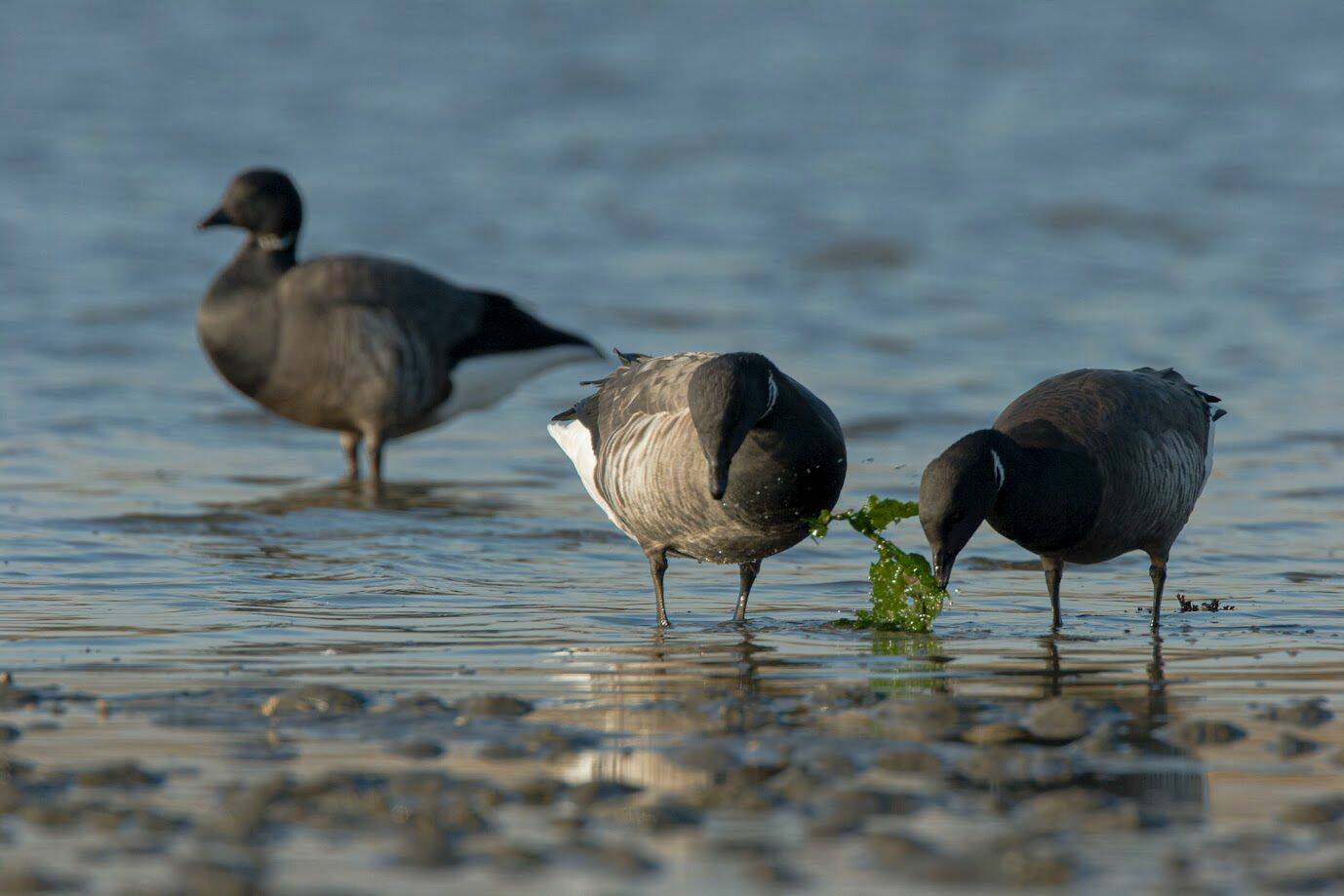
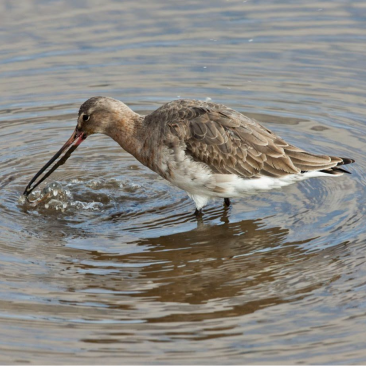
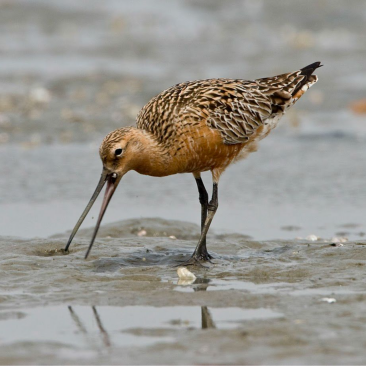

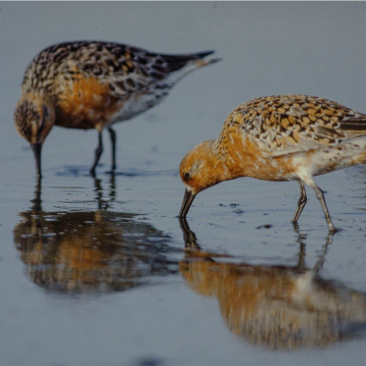
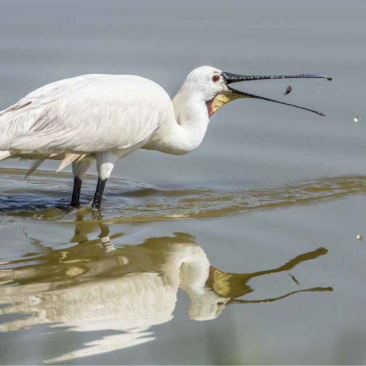

TEXT: NIENKE BEINTEMA | PHOTOS: JAN VAN DE KAM
The ‘Watchbirds’ project has been launched: an initiative of the UG centre BirdEyes. Knot, spoonbill,
bar-tailed godwit, sanderling, brent goose, and black-tailed godwit: these birds all have something to do with the Wadden. Based on the stories of these six migratory bird species, biologists investigate the ecology behind changes. ‘You can only take significant measures once you know why something works.’
“
Theunis Piersma:
‘It’s not just about the hard data,
it’s also about the stories these
birds tell’
Heralds of autumn. That is what migratory birds are, as they swarm over our Wadden in autumn. They gather here to fatten up, on their way to their wintering grounds in Africa. They return in spring, via the Wadden Sea, to their breeding grounds in the far north. Then there are the migratory birds that either breed here, or stay through the winter. To all these species, the Wadden region is crucial.
These migratory birds are also heralds of change: when the Wadden are doing well, they thrive. When the Wadden are doing badly, they dwindle – like canaries in a coal mine. That is the basic idea behind Watchbirds, a major project from BirdEyes that was launched earlier this year. It is the UG’s new Centre for Global Ecological Change, located in the heart of Leeuwarden.
Understanding what is happening
‘Studying migratory wading bird populations is crucial if you want to recognize and understand changes in the Wadden area,’ says initiator Theunis Piersma, professor of migratory bird ecology at the UG. ‘We have been counting and measuring for a very long time. And many nature restoration projects are taking place, using the “shovel in the ground” motto. However, not enough attention is paid to the underlying ecology.’
Why do wading birds choose a particular stretch of Wadden Sea over another, and why do their numbers change? Why do these ‘shovel-in-the-ground’ projects work, or fail? ‘You can only take sensible measures once you know these things,’ Piersma firmly states.
Five parties are funding the Watchbirds project, which will span a total of five years: the Wadden Fund, the Ministry of LNV, and the three Wadden provinces. Eight of the required 10 million euros have already been secured. Six distinctive bird species have been selected as emissaries of the project - six species that together represent the entire Wadden ecology.
Story-telling
‘This approach will generate a lot of fundamental knowledge,’ says BirdEyes project leader Tjibbe Stelwagen. ‘But above all, we are going to make sure that this knowledge ends up with custodians, such as Natuurmonumenten and the Provincial Landscapes. That is why they are also represented in Watchbirds.’
The researchers will conduct observations, counts, and prey analyses, among other things, as well as tagging many birds with transmitters. Stelwagen: ‘We will literally be able to see when the birds are where, we will learn how they use space, we will immediately notice deviations from patterns. We can work with that information: together, we can discover how to manage the Wadden area as sustainably as possible.’
Spectacular
The approach is unique, say Piersma and Stelwagen - and perfectly fits with BirdEyes' vision: to see the world through the eyes of birds. ‘It’s not just about the hard data, it’s also about the stories these birds tell’, Piersma stresses. Stelwagen: ‘We would like for people to experience that sense of wonder. If you follow a tagged bird, if you watch it migrate and raise its offspring, if you see how it endures good times and bad times... that is spectacular. That is when the data comes alive - and that is when you want to get involved.’


PHOTO: KEES VAN DE VEEN
READING TIME: 5 MINUTES
Theunis Piersma, professor og migratory bird ecology
heralds of change
in the Wadden
Watchbirds
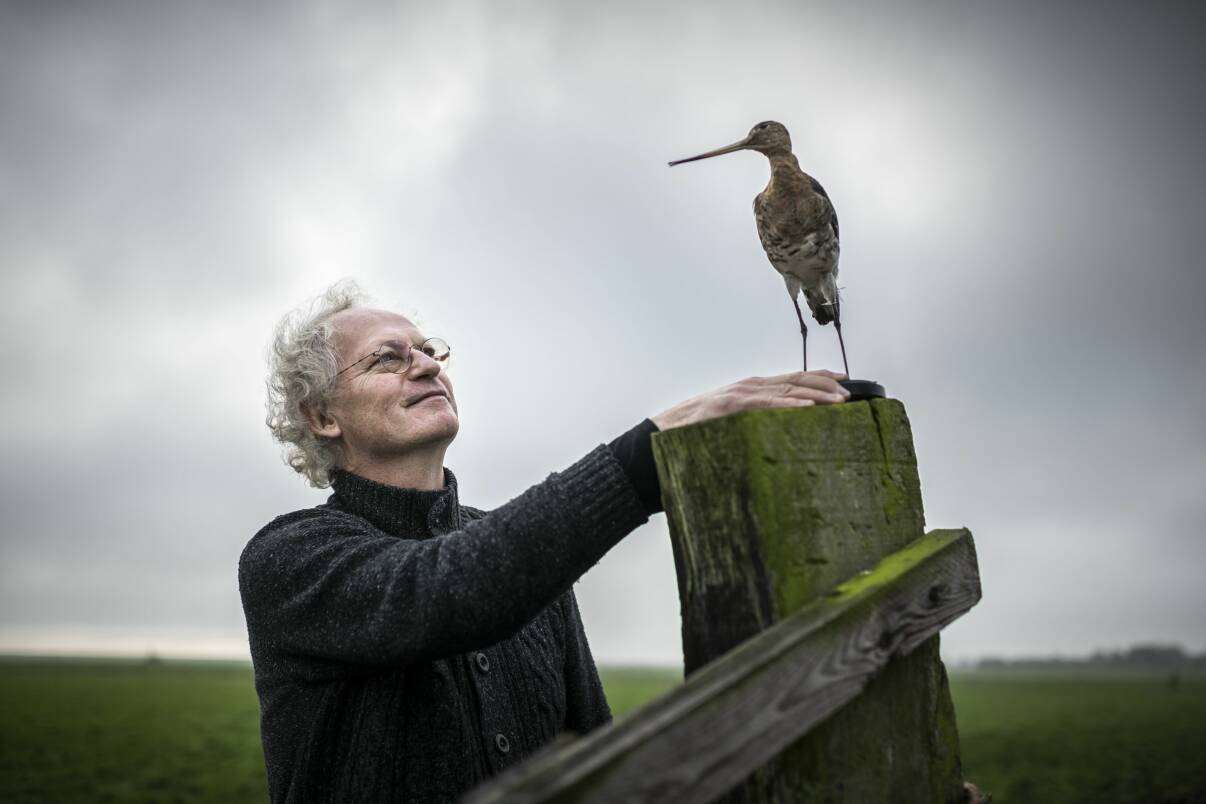
Black-tailed godwit
The sixth bird on the list is the black-tailed godwit. As an inhabitant of our grasslands, it is not technically a wading bird, but since it is a much-loved breeding bird of the Wadden Islands and the North Holland, Frisian, and Groningen Wadden coast, it still belongs in the list. And, as an icon of Dutch farmland, it may rightly be called a ‘watchbird’. It was with good reason that the black-tailed godwit was voted our national bird in 2015. It is somewhat larger and slimmer than its bar-tailed counterpart, with a longer bill and longer legs, and it is slightly less brightly coloured. In autumn, black-tailed godwits fly to West Africa, only to return north during the winter.
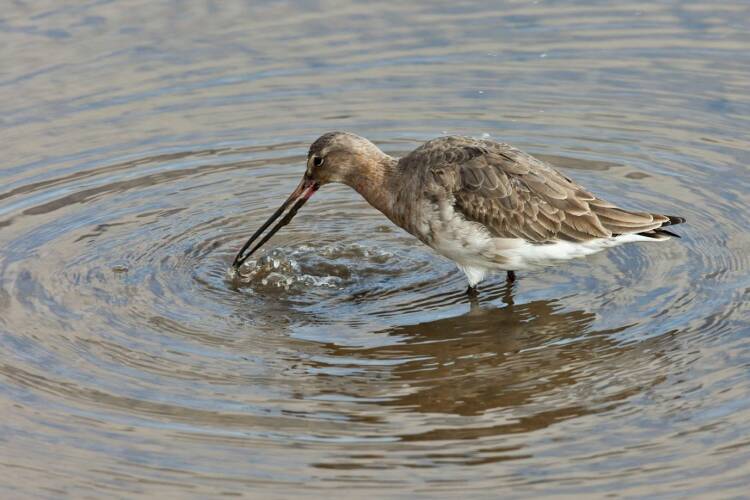
PROPOSITION
Bar-tailed godwit
This lesser-known cousin of our ‘common’ black-tailed godwit is somewhat smaller and stockier, and has a slightly upturned bill. It is a striking wading bird that prefers to eat bristle worms, such as lugworms and sandworms – but it also likes other invertebrates. Bar-tailed godwits breed in the far north and are mostly passing through here. Scandinavian breeders winter in the Wadden Sea; we also see birds on their way from Siberia to West Africa. The Pacific subspecies holds the world record for non-stop long-distance flying: in 2022, a tagged Alaskan flew to Tasmania in 11 days, which is over 13,500 km in one go.
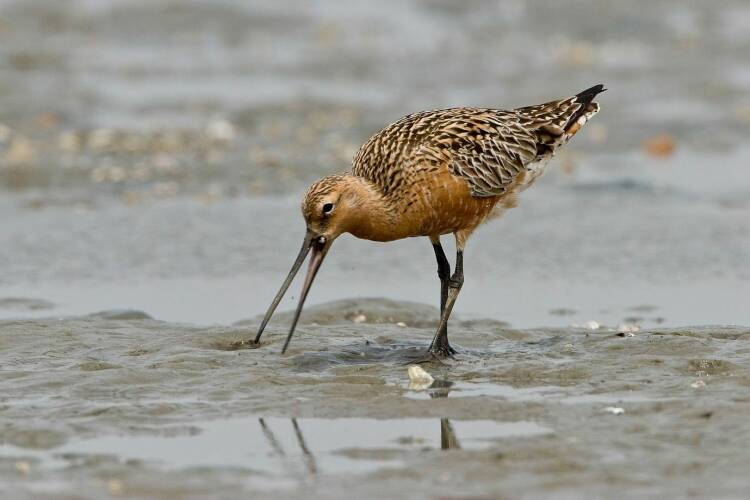
Berit Habbig Libutzki – Medical Sciences
‘Feminism isn’t about making women stronger. Women are already strong. It’s about changing the way the world perceives that strength’
(G.D. Anderson)
Sanderling
In small groups, they run ahead of the waves, back and forth on the beach, always moving. Their little legs move so fast they almost seem to float. Sanderlings are called three-toed-sandpiper in Dutch because they do not have a fourth toe like other birds: the hind toe is missing. They search for small creatures in the tide line on the beach. You can find them all along the coast, but especially in the Wadden area. Like knots, they breed in the high-Arctic tundra and, at that time, they are a deep rusty brown; here they are greyish-white, although they look black and white when in flight. Some stay with us all winter, while others migrate to West Africa.
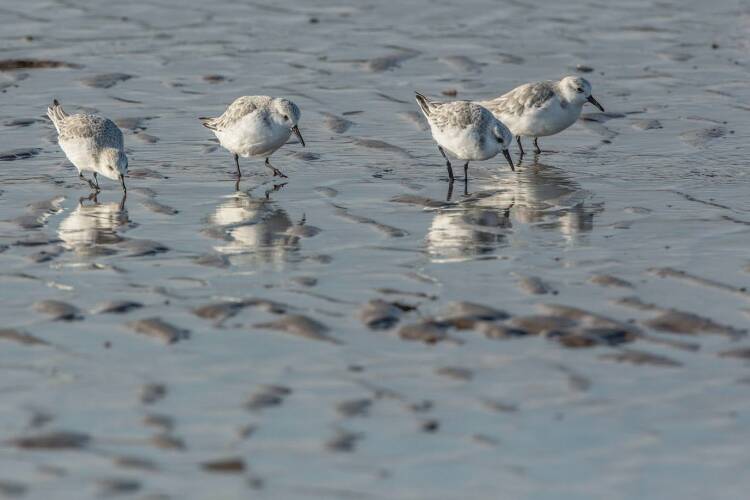
Knot
Our largest species of sandpiper is magnificent. It is grey and white in winter, but during summer it is colourful on top and reddish-brown underneath. Knots breed in the high Arctic and then flock to the Wadden to fatten up. The Siberians fly on to West Africa, but knots from Greenland and Canada, a separate subspecies, stay with us throughout the winter. This makes the Wadden Sea essential for this species. Knots are experts at finding shellfish on the tidal flats. You can often see them close together in large groups: resting on dry ledges or swarming through the air.
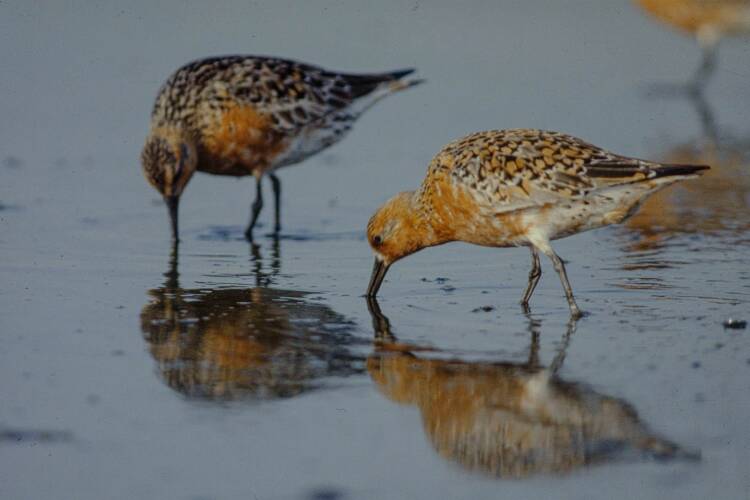
Spoonbill
Half a century ago, this was a rare bird in these parts. Now, almost four thousand pairs breed mainly in the Wadden area, but also in other coastal and marsh areas. The spoonbill is a migratory bird, like the brent goose, but this one breeds here and migrates for winter to southern Europe, or even further: to the mudflats along the coast of Mauritania. Spoonbills forage in shallow water: in gullies on the mud flats and ditches on the salt marsh, for example. They can also be found in freshwater, zigzagging through the mud with their spoon-beak, looking for small fish. Piersma and colleagues even wrote a book about one special, tagged female: Sinagote – The Biography of a Spoonbill.


Brent goose
It looks black and white, this small graceful goose, but if you look closely, you will find that it has over a hundred colours: from coal black to creamy white, with the most beautiful shades in between. The brent goose owes its name to its sound: a distinctive rrrô-rrrô, which may be a soft cooing or a sharp and short sound. Brent geese breed on northern tundra and come our way for the winter. The Dutch Wadden area is very important for them: the majority of the world population settles here for brief periods or longer. They eat eelgrass on the mud flats, graze on salt marshes and in polders, and they like to bob around at sea. In other words, a true wading bird.
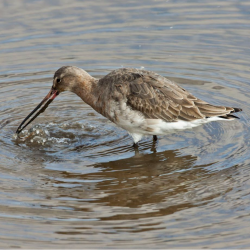
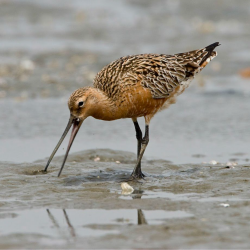

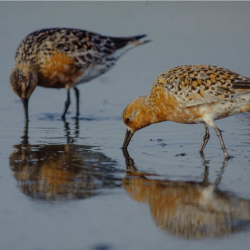

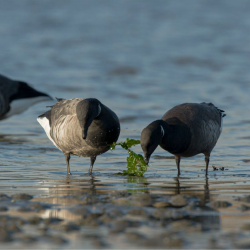
“
Theunis Piersma:
‘It’s not just about the hard data,
it’s also about the stories these
birds tell’
Heralds of autumn. That is what migratory birds are, as they swarm over our Wadden in autumn. They gather here to fatten up, on their way to their wintering grounds in Africa. They return in spring, via the Wadden Sea, to their breeding grounds in the far north. Then there are the migratory birds that either breed here, or stay through the winter. To all these species, the Wadden region is crucial.
These migratory birds are also heralds of change: when the Wadden are doing well, they thrive. When the Wadden are doing badly, they dwindle – like canaries in a coal mine. That is the basic idea behind Watchbirds, a major project from BirdEyes that was launched earlier this year. It is the UG’s new Centre for Global Ecological Change, located in the heart of Leeuwarden.
Understanding what is happening
‘Studying migratory wading bird populations is crucial if you want to recognize and understand changes in the Wadden area,’ says initiator Theunis Piersma, professor of migratory bird ecology at the UG. ‘We have been counting and measuring for a very long time. And many nature restoration projects are taking place, using the “shovel in the ground” motto. However, not enough attention is paid to the underlying ecology.’
Why do wading birds choose a particular stretch of Wadden Sea over another, and why do their numbers change? Why do these ‘shovel-in-the-ground’ projects work, or fail? ‘You can only take sensible measures once you know these things,’ Piersma firmly states.
Five parties are funding the Watchbirds project, which will span a total of five years: the Wadden Fund, the Ministry of LNV, and the three Wadden provinces. Eight of the required 10 million euros have already been secured. Six distinctive bird species have been selected as emissaries of the project - six species that together represent the entire Wadden ecology.
Story-telling
‘This approach will generate a lot of fundamental knowledge,’ says BirdEyes project leader Tjibbe Stelwagen. ‘But above all, we are going to make sure that this knowledge ends up with custodians, such as Natuurmonumenten and the Provincial Landscapes. That is why they are also represented in Watchbirds.’
The researchers will conduct observations, counts, and prey analyses, among other things, as well as tagging many birds with transmitters. Stelwagen: ‘We will literally be able to see when the birds are where, we will learn how they use space, we will immediately notice deviations from patterns. We can work with that information: together, we can discover how to manage the Wadden area as sustainably as possible.’
Spectacular
The approach is unique, say Piersma and Stelwagen - and perfectly fits with BirdEyes' vision: to see the world through the eyes of birds. ‘It’s not just about the hard data, it’s also about the stories these birds tell’, Piersma stresses. Stelwagen: ‘We would like for people to experience that sense of wonder. If you follow a tagged bird, if you watch it migrate and raise its offspring, if you see how it endures good times and bad times... that is spectacular. That is when the data comes alive - and that is when you want to get involved.’
The ‘Watchbirds’ project has been launched: an initiative of the UG centre BirdEyes. Knot, spoonbill,
bar-tailed godwit, sanderling, brent goose, and black-tailed godwit: these birds all have something to do with the Wadden. Based on the stories of these six migratory bird species, biologists investigate the ecology behind changes. ‘You can only take significant measures once you know why something works.’
TEXT: NIENKE BEINTEMA | PHOTOS: JAN VAN DE KAM